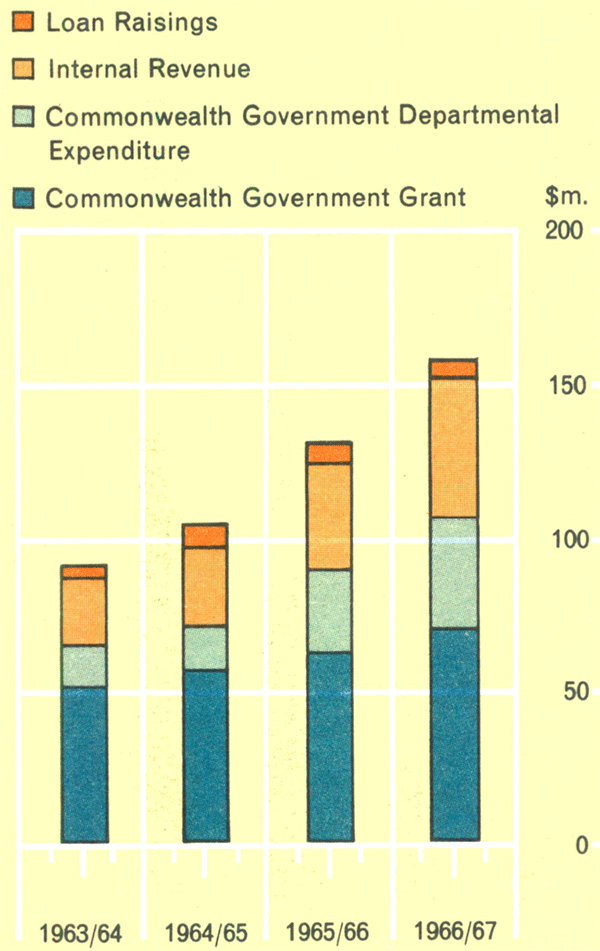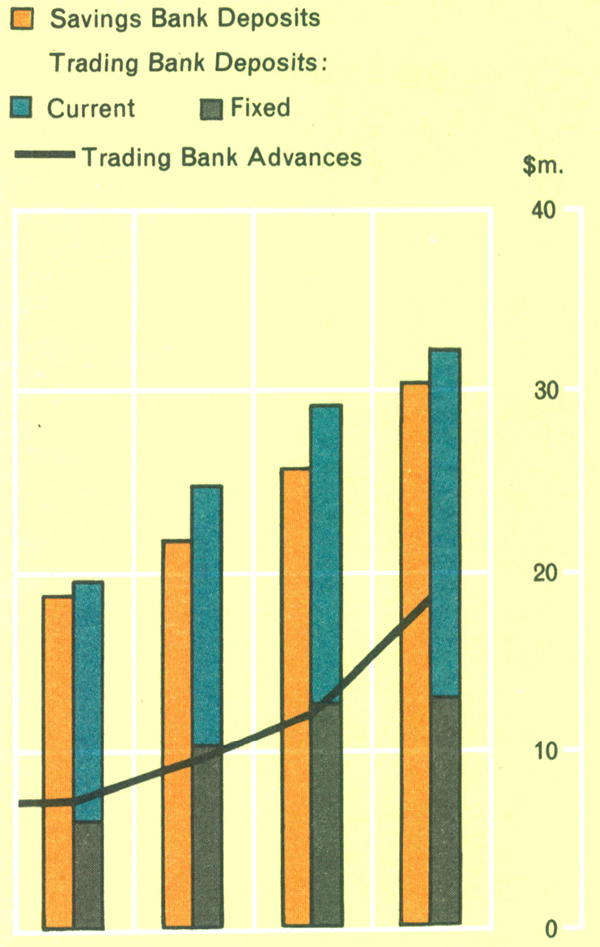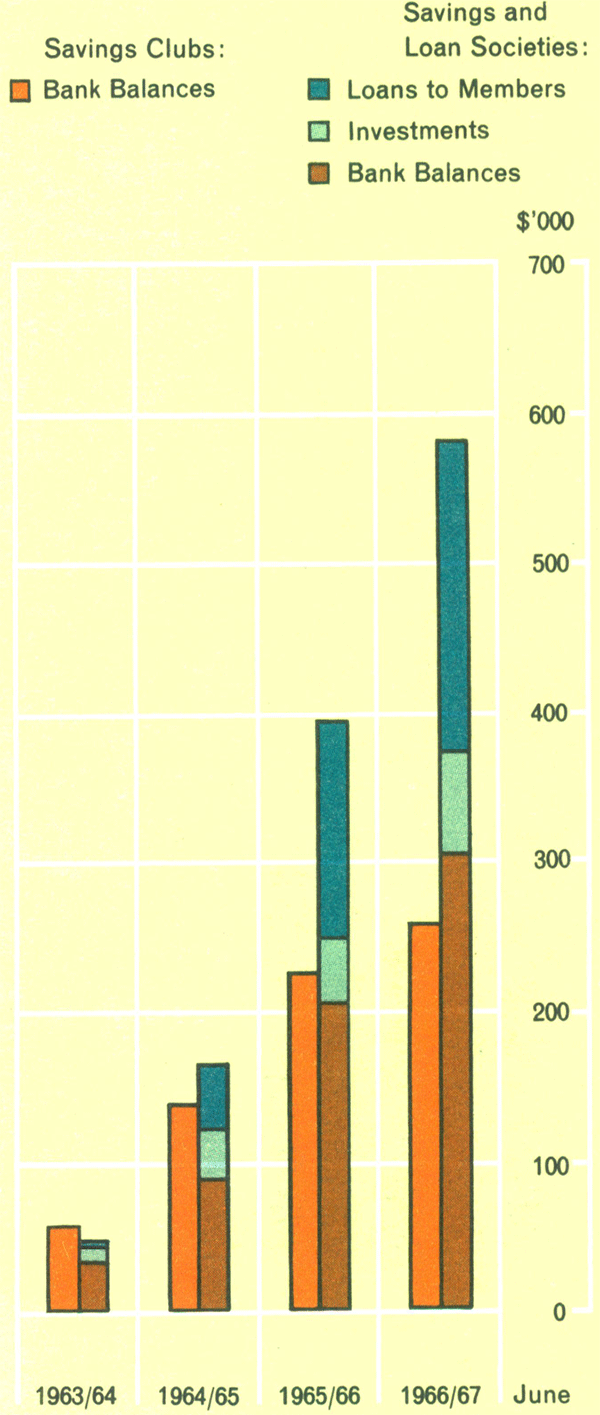Reserve Bank of Australia Annual Report – 1967 Papua and New Guinea
Expenditure and Economic Activity
Economic activity in the Territory of Papua and New Guinea continued to increase during 1966/67, mainly under a strong stimulus from rising government expenditure but also as a result of increasing private expenditure. Accompanying the general growth of the economy has been a gradual widening in the use of money.
Spending by the Administration increased by 16 per cent, which was slightly more than the increase in the preceding year. This was financed by a non-repayable grant from the Australian Government of $70 million, loan raisings of $6 million and internal receipts amounting to approximately $44 million. Comparable amounts in 1965/66 were $62 million, $6 million and $35 million respectively. In addition, direct expenditure by Commonwealth Government departments in the Territory during 1966/67 was about $37 million, a rise of $7 million on 1965/66.
Graph 21
T.P.N.G. Government Expenditure
Source of Funds

A substantial proportion of official expenditure was for capital works; three new institutions—the University of Papua and New Guinea, the Institute of Higher Technical Education and the Papua and New Guinea Development Bank—received funds for their establishment.
Production of most primary products increased during the year but copra was slightly below its 1965/66 level. With more favourable seasonal conditions cocoa production recovered from the depressed levels of 1965/66 and the coffee crop was at a record high. Production of timber rose, in response to increasing demand for logs from overseas and for sawn timber from the building sector. However, imports caused some local marketing problems for sawn timber. Rubber production improved slightly and production of two new commodities, pyrethrum and tea, increased slowly; the first commercial tea processing factory in the Territory opened in the Western Highlands during July 1966. Late in 1966/67 a joint Administration and private enterprise scheme to develop some 6,000 acres of oil palm on the West Coast of New Britain was announced.
The increase in government expenditure provided a substantial stimulus to the growth of other industries. The building industry grew in response to strong demand from both the public and private sectors. Secondary industry continued to expand and diversify but shortage of skilled labour remains a problem. The recent decision to permit skilled Asian workmen to remain in the Territory for limited periods could assist in some instances.
Improvements to the road system have assisted the growth of motor transport, and new motor vehicle registrations rose over the year.
The Consumer Price Index rose by 2 per cent during the year reflecting, in part, higher import and excise duties mostly on cigarettes and tobacco. The rise was, however, less than in the previous year. Wages generally increased during the year. During May, the Territory's Public Service Arbitrator handed down a judgement increasing salary levels for Papuan and New Guinean public servants. These increases averaged around 10 per cent of current salaries and could extend to wage levels in other sectors of the economy.
The rising volume of primary production was not fully reflected in higher export income because of a fall in some commodity prices—particularly for coffee and rubber. The examination of copper ore deposits in Bougainville continued throughout the year. Should it be decided to develop these deposits there would be a substantial addition to administrative revenues and a significant contribution to Territory export earnings through exports of copper. Provision has been made for the Territory Administration to take up part of the share capital in this project. Reflecting the rapidly rising levels of aggregate expenditure, imports continued to rise particularly strongly; imports of foodstuffs, manufactured goods and machinery, in particular, increased significantly. As a result of imports rising faster than exports the trade deficit continued to widen during the year.
Finance
Both bank deposits and funds lodged with savings and loan societies and savings clubs increased during the year. Savings bank deposits increased by $3.9 million during the twelve months to June 1967 when they totalled $29.8 million while the number of accounts increased by 44,000 to 286,000; these increases were slightly less than those recorded during the preceding twelve months. Trading bank deposits at the end of the year totalled $32.2 million, having increased by $3.1 million over the twelve months. This increase was a little less than that recorded in 1965/66. Current deposits increased at a faster rate than in the previous year but fixed deposits which had been the most buoyant component of deposits during the previous two years levelled out.
A significant feature of banking operations during the year was the substantial rise in trading bank advances. In June 1967 these amounted to $18.8 million which was 53 per cent higher than in June 1966. This rise was due mainly to increased lending to the finance, building construction and commerce sectors. The Reserve Bank, through its Rural Credits Department, for the first time made finance available to assist the processing and marketing of Territory coffee.
Savings and loan societies and savings clubs continued to expand during the year and now are operating in 15 districts of the Territory. Membership of these bodies rose by 1,736 to total 24,042 at 30th June and savings mobilised increased by about 36 per cent to $840,000. There was a substantial increase in the demand for loan funds by society members and loans outstanding rose from $143,000 to $208,000. About half of the funds lent to date have been used for the purchase of motor vehicles and building materials; the money borrowed has also been used for the purchase of trade store goods and as business working capital.
The Federation of Savings and Loan Societies, formed by members on a Territory-wide basis in 1965/66, consolidated its position during the year. Activities of the Gazelle League of Savings and Loan Societies have widened and several full time officers have been appointed to its staff. The League now has its own premises in Rabaul which were completed in March 1967.
The Papua and New Guinea Development Bank opened for business early in July 1967. The Board of Directors of twelve members was appointed in August 1966, six of the Directors being Territory residents. The function of the Bank is to provide longer term credit for developmental purposes with particular attention to be paid to the needs of small-scale indigenous undertakings.
A mission from the International Bank for Reconstruction and Development visited the Territory in March 1967 to bring up to date the Bank's information on the Territory and to examine a number of projects to determine their suitability for financial assistance from organisations of the Bank. To the end of June 1967, no commitments had been announced by the Bank.
The Reserve Bank's Advisory Committee on Central Banking in the Territory, established late in 1966, met several times during the year. Members, comprising permanent residents of Papua and New Guinea, the Territory Treasurer and representatives of the Reserve Bank, discussed the Bank's activities in the Territory and aspects of economic financial development.
Throughout the year the Bank continued its efforts to improve the community's understanding of economic and financial matters. A member of the Bank's staff has been engaged full time in liaison with educational authorities and in lecturing on financial topics to groups both at schools and training institutions. In addition, the Bank has recently released new editions of several of its financial booklets.
Staff
At the end of 1966/67 the Reserve Bank's staff in the Territory totalled 58, of whom 44 were indigenes. In addition, 4 officers were on secondment to the Bank from the commercial banks for duties associated with the formation of savings and loan societies. The programme for training Papuan and New Guinean officers for positions of increasing responsibility in the Bank's service has continued. This training has been helped by the establishment in conjunction with other banks operating in the Territory of a Papua and New Guinea Bankers' College and the appointment of a full time Education and Training Officer. In-service training for indigenous staff has included training in Australia for some of the more promising officers. In addition, five members of the Bank's staff are currently attending tertiary institutions in the Territory and 18 members are enrolled as correspondence students with Australian educational establishments. Seven Papuans and New Guineans are attending secondary schools in Australia under Reserve Bank scholarships.
Graph 22/23
T.P.N.G. Banking Statistics

T.P.N.G. Savings Clubs & Savings & Loan Societies
Distribution of Funds
